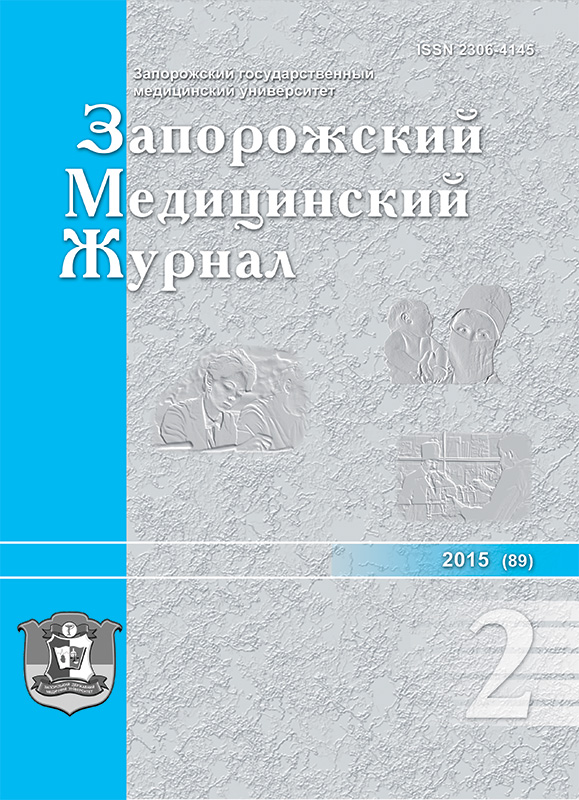Carbohydrate and lipid metabolism indices dynamic in patients with postinfarction cardiosclerosis, type 2 diabetes and obesity in 6 months and 1 year after myocardial revascularization
DOI:
https://doi.org/10.14739/2310-1210.2015.2.42013Keywords:
Myocardial Infarction, Sclerosis, Revascularization Myocardial, Obesity, Diabetes MellitusAbstract
Nowadays conservative therapy and reperfusion techniques, which include thrombolytic therapy and percutaneous coronary intervention considered as the main strategies for the acute coronary syndrome treatment.
Aim. To assess carbohydrate and lipid metabolism in patients with postinfarction cardiosclerosis, type 2 diabetes and obesity in 6 months and 1 year after myocardial revascularization.
Methods and results. 58 patients who underwent thrombolytic therapy and 32 patients who underwent percutaneous coronary intervention were examined. Glucose level was determined by glucose oxidation method, insulin – by ELISA and lipid profile – according to the standard biochemical methods.
It was established that in patients with postinfarction cardiosclerosis, type 2 diabetes and obesity positive effect was defined in carbohydrate and lipid metabolism by reducing of serum glucose level, insulin, total cholesterol, low and very low-density lipoproteins, triglycerides and increasing of high density lipoproteins, cholesterol in 6 months and 1 year after reperfusion therapy. Significant differences in carbohydrate and lipid metabolism in the examined patients, depending on the type of reperfusion therapy, have not been detected in 6 months and 1 year after revascularization.
Conclusion. Comparative analysis of different methods of myocardial revascularization did not show any advantages of them.
References
Sirenko, Ju. M., Stepanenko, A. V., Morozov, A. M., et al. (2014) Hostryi koronarnyi syndrom z elevatsiieiu sehmenta ST. Adaptovana klinichna nastanova, zasnovana na dokazakh [Acute coronary syndrome with elevation segment ST. Graded clinical guidelines based on evidence]. Kyiv. [in Ukrainian].
Roger, V. L., Go, A. S., Lloyd-Jones, D. M., Benjamin, E. J., Berry, J. D., Borden, W. B., et al. (2012) Executive summary: heart disease and stroke statistics–2012 update: a report from the American Heart Association. Circulation, 125, 188–197. doi: 10.1161/CIR.0b013e3182456d46
(2007) ESC. Guidelines for the diagnosis and treatment of non–ST–segment elevation acute coronary syndromes. Eur. Heart. J., 28, 1598–1660.
The second Euro Heart Survey on acute coronary syndromes: characteristics, treatment, and outcome of patients with ACS in Europe and the Mediterranean Basin in 2004 (2006). Eur. Heart. J., 8, 196–205. doi:10.1093/eurheartj/ehl196.
Thygesen, K., Alpert, J. S., Jaffe, A. S., Simoons, M. L., Chaitman, B. R., White, H. D., et al. (2012) Third universal definition of myocardial infarction. Circulation, 126, 2020–2035. doi: 10.1161/CIR.0b013e31826e1058.
Online version of IDF Diabetes Atlas, Sixth edition (2013). Retrieved from www.idf.org/diabetesatlas.
Cantor, W. J., Fitchett, D., Borgundvaag, B. et al. (2009) Routine early angioplasty after fibrinolysis for acute myocardial infarction. N Engl J Med., 360, 2705–2718.
Fernandez-Aviles, F., Alonso, J. J., Pena, G. Blanco, J., Alonso-Briales, J., López-Mesa, J., et al. (2007) Primary angioplasty vs. early routine post-fibrinolysis angioplasty for acute myocardial infarction with ST-segment elevation: the GRACIA-2 non-inferiority, randomized, controlled trial. Eur Heart J., 28, 949–960. 10.1093/eurheartj/ehl461
Danchin, N., Coste, P., Ferrieres J., et al. (2008) Comparison of trombolysis followed by broad use of percutaneouse coronary intervention with primary percutaneouse coronary intervention for ST-segment elevation acute myocardial infarction data from the French registry on acute ST-elevation myocardial infarction (FAST-MI). Circulation, 118, 268–276.
Eagles, K. A., Nallamothu, B. K., Mehta, R. H., Granger, C. B., Steg, P. G., Van de Werf, F., et al. (2008) Trends in acute reperfusion therapy for ST-segment elevation myocardial infarction from 1999 to 2006: we are getting better but we have got a long way to go. Eur. Heart J., 29, 609–617. doi: 10.1093/eurheartj/ehn069.
Glover, M. B., Adgey, A. A. J. (2008) Acute reperfusion strategies for ST-segment elevation myocardial infarction. Eur. Heart J., 29, 571–572. doi:10.1093/eurheartj/ehm277.
Downloads
How to Cite
Issue
Section
License
Authors who publish with this journal agree to the following terms:
Authors retain copyright and grant the journal right of first publication with the work simultaneously licensed under a Creative Commons Attribution License that allows others to share the work with an acknowledgement of the work's authorship and initial publication in this journal. 

